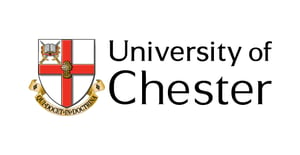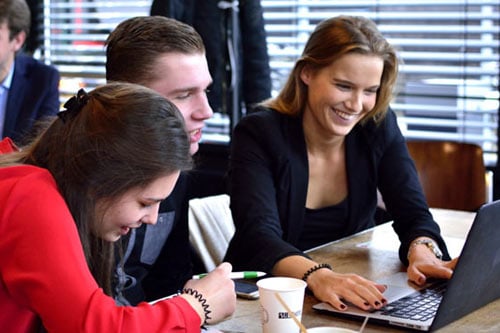"Part of my PG Certificate investigated group work and simulations to identify the problem I had with student engagement. Business simulations have been reported to close that application gap by exposing students to real business situations to apply skills and theory in a safe environment. It shifts that learning from passive techniques to active, participative techniques. This was well reflected in the literature during my research." Dr. Peter Barton, Lecturer in Strategic Management, Liverpool Business School
Let's Talk Strategy!
On Thursday 10th March we held a webinar together with guest speaker, Dr. Peter Barton from Liverpool Business School to discuss his approach to teaching strategic management through business simulations.
In this blog article, we provide a recap of the key highlights and insights discussed during the session.
The Stimulation of simulations and Dale's 'Cone of Learning' (1969)
"I have to confess I had slightly unrealistic expectations around students' willingness to read and engage around seminars and case studies. Part of my PG Cert qualification that I undertook at Liverpool John Moores University investigated group work around simulations, looking for solutions to improve student engagement."
Having identified a problem with student engagement during seminar and case study activities, Peter's research led him to look at business simulations as a pedagogical tool to remedy the engagement problem and get students interested and invested in learning and applying strategic management theory.
"Business simulations have been reported to close that application gap by exposing students to real business situations to apply skills and theory in a safe environment. It shifts that learning from passive techniques to active, participative techniques. This was well reflected in the literature during my research."
Peter also looked at Edgar Dale's 'Cone of Learning' model (1969) that showed how more active doing rather than reading, hearing and watching is more effective in retaining knowledge.
"This suited higher learning outcomes so for me teaching level 6 modules where there is a higher level of thinking required, focused on analysis, evaluation, decision-making where students really need to think about the higher learning outcomes are required."
Using Business Simulations to Improve Student Engagement and Skills Development
"Higher Education is often criticised for relying heavily on theory lacking application to the real-world. Whilst that theoretical understanding is important, students increasingly require communication skills, critical analysis, innovation, decision-making skills. This requires a multi-disciplinary approach."
From Peter's research he found seven key benefits from using simulations as tools to improve student engagement and develop key employability skills.
- Motivation - "Real experience leads to so much more enjoyment [from students] and deeper learning."
- Problem-solving - "Students are trying to problem solve which encourages critical and analytical thinking"
- Transfer of knowledge - "Through seminars or workshops, students are in place to do the work. Through the simulation you can coach on the side to guide students in the task but primarily leaves them to undertake it."
- Decision and cross-functional skills - "There are a lot of business functions and disciplines that simulations encompass as a whole such as finance, HR, marketing. The strategic management side of the simulations provides students with this helicopter view of the whole business and what decisions they need to make in each of these functions to improve company performance."
- Increased retention of knowledge - "A lot of good teaching is around story-telling. We remember things as stories and experiences through situations like simulations. Students can tell their story of the simulation because it's from their own experience."
- Adaptable learning - "It's safe using a simulation, students can make and learn from their mistakes because there are no real consequences. Lecturers can also encourage students to become more entrepreneurial in this safe environment and enable them to adapt to new events and changes to their company throughout."
- Behavioural, attitudinal, and knowledge exchange - "Students' attitudes can really improve as they share their experiences. The best seminars are where students are communicating with each other and discussing their own experiences with little teacher-led instruction."
With the research backing-up Peter's hypothesis of having more active, participative learning to improve student engagement and develop key skills, the next step was to test this hypothesis by rolling-out a business simulations exercise.
Simulations in Practice - Large Cohorts? No problem
"Some people say simulations with too many [students] will be a problem. I think the opposite. I had 210 last year and I found that the structure the simulation gives is excellent."
Peter shared an overview of how the simulations have been rolled out across his strategic management modules, particularly referencing how large groups of students can add structure to the target learning outcomes and how the group dynamic of the simulation benefits not just the rapport between Lecturer and student but also with fellow students themselves.
"It's actually quite social, you can wander around and get to know students really quickly in each of the groups. It's a great way to build rapport. Even during lockdown, I enjoyed the breakout rooms on Zoom. If you let them work with their friends when they know each other, they'll socialise, get together and work hard and effectively as a team."
Attendance rate was also highlighted as a key benefit from the simulation exercise.
"Generally it's been a 90% and above rate for attendance and other seminar leaders have also seen similar rates...so for students if you're not there you can't engage!"
Peter also saw how students were able to apply theory into practice, from lecture to seminar.
"Lecturers can bring in theory from the lecture and refer to it in the seminar but as students get more comfortable with the simulation they end-up doing this themselves so our role becomes more of a 'coach', helping and motivating students to find their own solutions."
Learnings and Best Practices
"Modules that used the Edumundo simulation had a 90% and above satisfaction rating as opposed to around 72% with no simulation presence."
Towards the end of the webinar Peter shared his feedback on learnings and best practices for fellow academics to consider when using a simulation in their teaching.
- TIME-CONSUMING? NOT ON MY WATCH...
"The amount of time I undertook was easily outweighed by the time saved later on in terms of assignment design. It was actually quite time-efficient once the groups had been assembled and enrolled by Edumundo."
-
Optimal Number of Seminars and Groups
"Each market focus served as a seminar for us. We found groups of 3-5 students worked well, possibly 6 but higher numbers can complicate the group dynamic and open opportunities for students to switch-off."
-
Student Support - focus on teaching; Edumundo takes care of the rest
"Edumundo have been very good in making it clear that the Lecturers are experts in strategic management but Edumundo are experts on the simulation. Lecturers are not expected to know the simulation inside and out, hence why they have a Helpdesk to answer Lecturers' and students' queries and why they provide training and Q&A sessions for students beforehand."
-
Adaptable for Remote Learning
"There's a bit more work to setup the breakout rooms but once that is set-up it works really well but still remember to limit the groups sizes so they aren't too big."
-
Module/course Assessment - Make it relevant to the simulation
"Making sure the simulation is linked to module assessment is really important. Students are always thinking about how the information or task relayed is of relevance to their assignments. I use a group presentation assignment but weight that at 20% of the marks with an individual reflective assignment making-up the rest of the assessment. Having a combination of group and individual assessment really tests their acquired skills and knowledge. It also helps reduce plagiarism because essays bought online or written by someone else cannot replicate this experience [undertaking the simulation]."
-
Module Feedback - Measuring Student Satisfaction
"Modules that used the Edumundo simulation had a 90% and above satisfaction rating as opposed to around 72% with no simulation presence. What was most powerful was the quality of comments from students. They mentioned a better application of learning and a greater chance of working with fellow students. Some didn't like the group work but many did and learned a lot from the experience as the feedback evidenced."
Q&A Session - Any questions for the Lecturer?
The webinar culminated with a Q&A session with participants able to ask questions to Peter about his experience with simulations. Here were three examples of the questions asked together with Peter's and Leon's responses.
- "How can the simulation link theory to practice?"
Peter: "I will give you an example, I take a theme from one of the lectures e.g. monitoring the macro-environment and use that in the seminar as an activity they would do alongside the simulation. For example teaching and then applying PESTEL analyses to their company in the simulation." - "I'm moving to a 'block-teaching' format, are there any adjustments that would need to be made?"
Peter: "Everything else could remain the same apart from shortening the time students have to undertake each round of the simulation which Edumundo can tailor to the needs of the course/module." - "How can simulations be used across multiple sites?"
Leon: "We do have inter-school competitions and involving multiple campuses. All we would need to know is which campuses/universities would be involved and what students from each would need to be enrolled."
A big thank you to all our participants and our guest speaker, Dr. Peter Barton for taking the time to present his pedagogical research and implementation to using simulations to teach strategic management.
If you are interested in finding out more about our business simulations, click on the button below otherwise sign-up for updates on future webinars further down.
Did you miss the webinar? Don't worry...
View the recording or check out our recap video
Looking forward to Our next webinar? Keen to Find out more?
Sign-up to our newsletter for updates.
Article References:
Dale, E. (1969). Audiovisual methods in teaching (3rd ed.). New York: Dryden Press.



.png?length=300&name=unnamed%20(11).png)
.png?length=300&name=unnamed%20(7).png)
.png?length=300&name=unnamed%20(8).png)
.png?length=300&name=unnamed%20(6).png)

.png?length=300&name=unnamed%20(10).png)
.png?length=300&name=unnamed%20(5).png)
.png?length=300&name=unnamed%20(9).png)
.png?length=300&name=unnamed%20(4).png)
.png?length=300&name=unnamed%20(2).png)
.png?length=300&name=unnamed%20(1).png)
.png?length=300&name=unnamed%20(3).png)
.jpg?length=300&name=unnamed%20(2).jpg)





.png?length=300&name=loughborough-university-logo%20(small).png)





